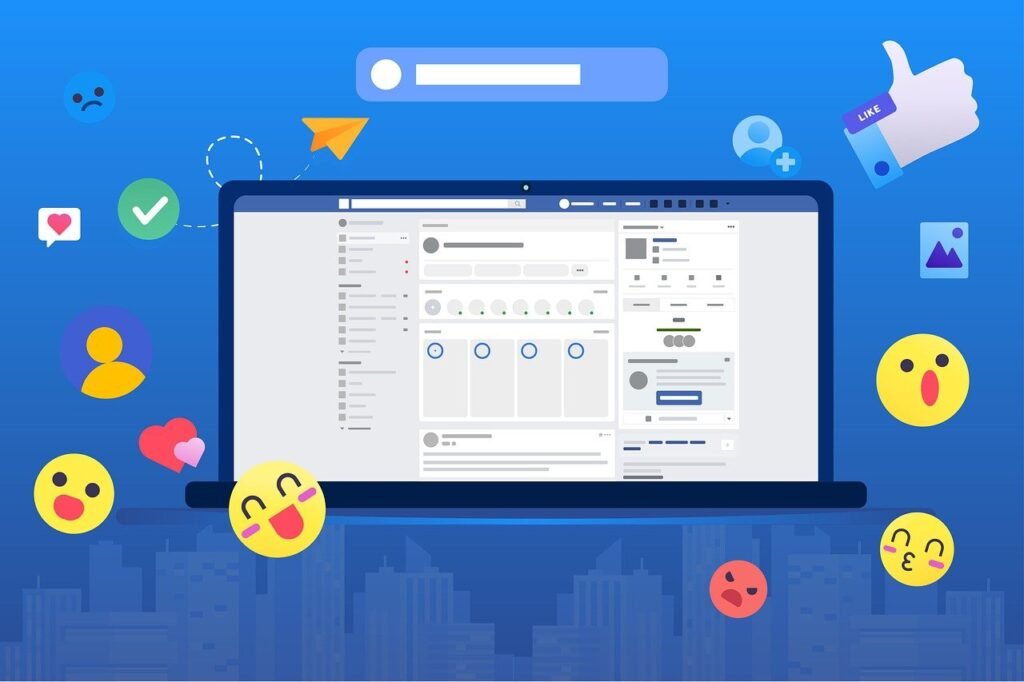- 1. How Many Monthly Active Users Does Facebook Have in 2024?
- 2. How Frequently Do Users Visit Facebook?
- 3. What Portion of Social Media Marketing Spend is Allocated to Facebook?
- 4. How Prevalent is the Use of Facebook Ads Among Marketers?
- 5. How Many Ads Does the Average Facebook User Click On Monthly?
- 6. How Important is Facebook for B2B Marketers?
- 7. What is the Projected Ad Revenue for Facebook in 2024?
- 8. How Does Facebook Influence Shopping Decisions?
- 9. What is the Average Cost Per Click for Facebook Ads?
- 10. How Do Video Posts Perform on Facebook?
- 11. How Popular Are Facebook Stories?
- 12. What is the ROI of Facebook Ads?
- 13. How Effective Are Facebook Live Videos?
- 14. How Important is Facebook to Social Media Marketers?
- 15. What is the Average Engagement Rate for Facebook Posts?
- 16. What is the Demographic Breakdown of Facebook Users?
- 17. How Do Users Access Facebook?
- 18. How Many Searches Are Conducted on Facebook Daily?
- 19. How Much Time Do Users Spend on Facebook Daily?
- 20. How Do Consumers Use Facebook for Product Discovery?
- 21. What is the Average Conversion Rate for Facebook Ads?
- 22. How Does Facebook Perform in Terms of Referral Traffic?
- 23. How Do Users Interact with Videos on Facebook?
- 24. How Popular Are Facebook Groups?
- 25. How Likely Are Facebook Users to Recommend Brands They Follow?
- 26. How Popular is Facebook’s Marketplace?
- 27. How Do Facebook Users Interact with Brands?
- 28. What is the Most Active Demographic on Facebook?
- 29. What Are Marketers' Plans for Facebook Ad Spend in 2024?
- 30. What is the Reach of Facebook's Advertising Audience?
- We got all the latest Marketing Stats here:
Facebook continues to dominate the social media landscape, making it a crucial platform for marketers in 2024. With its vast user base and diverse features, Facebook offers unparalleled opportunities for businesses to connect with their audience, drive engagement, and boost sales. Understanding the latest statistics can help marketers refine their strategies and maximize their ROI. In this article, we will explore essential Facebook marketing statistics for 2024, providing insights and actionable tips to enhance your marketing efforts.
1. How Many Monthly Active Users Does Facebook Have in 2024?

Facebook remains a social media giant with 2.96 billion monthly active users as of 2024. This massive user base makes it an indispensable platform for marketers aiming to reach a broad and diverse audience. The platform’s extensive reach ensures that businesses can connect with potential customers across different demographics and regions.
With nearly three billion users, Facebook offers unparalleled opportunities for brand visibility and engagement. Marketers can leverage this extensive user base to drive awareness, generate leads, and foster customer loyalty. It’s essential to create content that resonates with this diverse audience, utilizing Facebook’s targeting options to reach specific segments effectively.
2. How Frequently Do Users Visit Facebook?
A significant 74% of Facebook users visit the site daily, highlighting the platform’s importance in users’ daily lives. This frequent usage underscores the potential for consistent engagement and interaction with your audience.
For marketers, this means there’s a daily opportunity to connect with users through posts, ads, and stories. Regularly updating your content and maintaining an active presence on Facebook can help keep your brand top-of-mind for your audience. Additionally, leveraging Facebook’s algorithms to deliver timely and relevant content can enhance engagement and drive better results.
3. What Portion of Social Media Marketing Spend is Allocated to Facebook?
Facebook commands a significant share of the social media marketing budget, accounting for 19% of total social media marketing spend. This statistic indicates the platform’s value and effectiveness in delivering marketing results.
Investing in Facebook ads allows businesses to tap into its extensive targeting capabilities, ensuring that their messages reach the most relevant audience. With detailed analytics and performance metrics, marketers can continually optimize their campaigns for better ROI. Given its substantial share of marketing spend, it’s clear that Facebook remains a cornerstone of digital marketing strategies.
4. How Prevalent is the Use of Facebook Ads Among Marketers?
An overwhelming 93% of social media marketers use Facebook ads regularly. This widespread adoption highlights the platform’s effectiveness in reaching and engaging audiences. Facebook ads offer various formats, including image, video, carousel, and story ads, providing flexibility to create compelling campaigns.
Marketers can take advantage of Facebook’s robust ad targeting options, which include demographics, interests, behaviors, and more. This precision targeting ensures that ads are shown to the most relevant users, increasing the likelihood of conversions. Regular use of Facebook ads can help businesses maintain a strong presence on the platform and achieve their marketing goals.
5. How Many Ads Does the Average Facebook User Click On Monthly?
The average Facebook user clicks on 12 ads per month. This statistic underscores the platform’s potential for driving traffic and conversions through well-crafted ads.
To capitalize on this, marketers should focus on creating engaging and relevant ads that capture users’ attention. High-quality visuals, compelling copy, and clear calls-to-action are essential elements of successful Facebook ads. Additionally, regularly testing and optimizing ad performance can help improve click-through rates and overall campaign effectiveness.
6. How Important is Facebook for B2B Marketers?
Facebook is a key platform for B2B marketing, with 83% of B2B marketers using it as a content distribution channel. This statistic highlights the platform’s versatility and effectiveness in reaching business audiences.
For B2B marketers, Facebook offers opportunities to share thought leadership content, case studies, and industry insights. Engaging with business professionals through targeted ads and organic posts can help build brand authority and generate leads. Additionally, participating in industry-specific Facebook groups can facilitate networking and knowledge sharing.
7. What is the Projected Ad Revenue for Facebook in 2024?
Facebook’s ad revenue is projected to reach $117.6 billion in 2024. This staggering figure reflects the platform’s continued dominance in the digital advertising space.
For marketers, this projection underscores the importance of including Facebook in their advertising strategies. The platform’s extensive reach and advanced targeting capabilities make it a valuable tool for driving business growth. By allocating a portion of their advertising budget to Facebook, businesses can tap into its vast user base and achieve significant returns on their investment.
8. How Does Facebook Influence Shopping Decisions?
Facebook plays a crucial role in influencing shopping decisions, with 57% of consumers saying social media influences their shopping decisions, with Facebook being the leading platform. This influence highlights the importance of maintaining a strong presence on Facebook to drive sales.
Marketers can leverage Facebook to showcase products, share customer testimonials, and run targeted ad campaigns that resonate with potential buyers. By creating engaging and informative content, businesses can influence purchasing decisions and guide customers through the sales funnel. Additionally, interactive features like Facebook Live and Stories can enhance product visibility and engagement.
9. What is the Average Cost Per Click for Facebook Ads?
The average cost per click (CPC) for Facebook ads is $1.72. This cost-effective pricing makes Facebook ads accessible to businesses of all sizes, enabling them to reach their target audience without breaking the bank.
Marketers should focus on optimizing their ad campaigns to maximize ROI. This includes using precise targeting, creating compelling ad creatives, and continually monitoring performance metrics. By fine-tuning their strategies, businesses can achieve better results and lower their overall ad costs.
10. How Do Video Posts Perform on Facebook?

Video posts on Facebook have 135% greater organic reach than photo posts. This statistic underscores the power of video content in capturing users’ attention and driving engagement.
Marketers should prioritize video content in their Facebook strategies to maximize reach and engagement. Whether it’s short clips, live streams, or professionally produced videos, incorporating video content can help businesses connect with their audience on a deeper level. Additionally, using captions and engaging thumbnails can enhance the effectiveness of video posts.
11. How Popular Are Facebook Stories?
Facebook Stories have become a major feature on the platform, with over 500 million daily active users. This popularity underscores the importance of utilizing Stories in your marketing strategy.
Stories offer a unique, ephemeral way to engage with your audience. They appear at the top of the Facebook app, ensuring high visibility. Marketers can use Stories to share behind-the-scenes content, promotions, and interactive polls or quizzes. This format is particularly effective for creating a sense of urgency and fostering real-time engagement.
12. What is the ROI of Facebook Ads?
A significant 70% of marketers report Facebook ads provide excellent ROI. This high percentage indicates that Facebook ads are not only effective but also cost-efficient for most businesses.
To achieve excellent ROI, marketers should focus on precise targeting, engaging ad creatives, and ongoing optimization. By analyzing performance data and making data-driven adjustments, businesses can ensure their Facebook ads deliver strong results. Leveraging Facebook’s robust analytics tools can help marketers track key metrics and refine their strategies for maximum impact.
13. How Effective Are Facebook Live Videos?
Facebook Live videos are highly effective, producing 6 times as many interactions as traditional videos. This level of engagement highlights the value of live streaming for real-time interaction with your audience.
Marketers can use Facebook Live to host Q&A sessions, product launches, tutorials, and events. The live format allows for immediate feedback and interaction, making it a powerful tool for building community and driving engagement. Promoting live events in advance and encouraging audience participation can further enhance their effectiveness.
14. How Important is Facebook to Social Media Marketers?
Facebook is crucial for social media marketers, with 56% of them saying it is their most important social media platform. This importance underscores Facebook’s role as a primary channel for reaching and engaging audiences.
For marketers, maintaining an active and strategic presence on Facebook is essential. This involves regularly posting relevant content, engaging with followers, and leveraging Facebook’s advertising options. By prioritizing Facebook in their social media strategies, businesses can maximize their reach and impact.
15. What is the Average Engagement Rate for Facebook Posts?
The average engagement rate per post on Facebook is 3.6%. This rate highlights the platform’s potential for fostering interaction and building relationships with your audience.
To boost engagement rates, marketers should focus on creating high-quality, relevant content that resonates with their audience. This includes using visuals, videos, and interactive posts like polls and quizzes. Additionally, posting at optimal times and responding to comments can further enhance engagement.

16. What is the Demographic Breakdown of Facebook Users?
Facebook’s user base includes a significant portion of older adults, with 43% of users aged 35 and above. This demographic breakdown highlights the platform’s appeal to a wide range of age groups.
For marketers, understanding the demographic makeup of Facebook users is crucial for effective targeting. Tailoring content to appeal to specific age groups can enhance engagement and drive better results. Additionally, using Facebook’s targeting options to reach desired demographics can help optimize ad performance.
17. How Do Users Access Facebook?
A large portion of Facebook users access the platform via mobile devices, with 65% of users accessing Facebook exclusively via mobile devices. This statistic underscores the importance of mobile-friendly content and ads.
Marketers should ensure that their Facebook content and ads are optimized for mobile viewing. This includes using responsive design, short and engaging videos, and easily readable text. By focusing on mobile optimization, businesses can ensure a seamless user experience and maximize their reach.
18. How Many Searches Are Conducted on Facebook Daily?
Facebook generates 3 billion searches per day. This high volume of searches highlights the platform’s role as a major search engine and discovery tool.
For marketers, this means optimizing their Facebook pages and content for searchability. Using relevant keywords, hashtags, and detailed descriptions can help improve visibility in Facebook searches. Additionally, regularly updating content and engaging with followers can enhance discoverability and drive more traffic to your page.
19. How Much Time Do Users Spend on Facebook Daily?
The average Facebook user spends 33 minutes per day on the platform. This significant amount of time presents ample opportunities for businesses to engage with their audience.
To capture users’ attention during this time, marketers should focus on creating compelling and varied content. This includes a mix of posts, videos, stories, and live streams. Consistently posting high-quality content can keep your audience engaged and increase the likelihood of interactions and conversions.
20. How Do Consumers Use Facebook for Product Discovery?

A significant 75% of consumers have used Facebook to discover new products. This statistic underscores Facebook’s role as a key platform for product discovery and shopping inspiration.
Marketers can leverage Facebook to showcase their products through engaging posts, ads, and stories. Highlighting new arrivals, special promotions, and user-generated content can help attract attention and drive sales. Additionally, using Facebook Shops can provide a seamless shopping experience directly on the platform.
21. What is the Average Conversion Rate for Facebook Ads?
The average conversion rate for Facebook ads is 9.21%. This impressive rate highlights the platform’s effectiveness in driving conversions and achieving marketing goals.
Marketers can optimize their conversion rates by focusing on creating compelling ad creatives and precise targeting. Ensuring that landing pages are optimized for conversions and aligned with the ad content can also significantly improve results. Regularly testing different ad variations and analyzing performance data can help refine strategies and boost conversion rates.
22. How Does Facebook Perform in Terms of Referral Traffic?
Facebook is a dominant force in driving referral traffic, holding a 79% share of the social media market in terms of referral traffic. This statistic underscores the platform’s ability to drive significant traffic to websites and online stores.
To maximize referral traffic from Facebook, marketers should share engaging content that encourages clicks. This includes using eye-catching visuals, compelling headlines, and clear calls-to-action. Additionally, leveraging Facebook Groups and Pages to share valuable content can further boost referral traffic.
23. How Do Users Interact with Videos on Facebook?
A notable 85% of video views on Facebook happen with the sound off. This statistic highlights the importance of optimizing videos for silent viewing.
Marketers should ensure that their videos are effective without sound by using captions, text overlays, and engaging visuals. This approach ensures that the message is conveyed clearly, even if users are watching without sound. Additionally, creating visually appealing thumbnails can attract more viewers and increase engagement.
24. How Popular Are Facebook Groups?
Facebook Groups are widely used, with 1.8 billion people using them monthly. This popularity highlights the importance of Facebook Groups for community building and engagement.
For marketers, Facebook Groups offer a valuable opportunity to connect with highly engaged audiences. Creating or participating in relevant groups allows businesses to share content, gather feedback, and foster a sense of community. Engaging actively in groups can help build brand loyalty and drive meaningful interactions.
25. How Likely Are Facebook Users to Recommend Brands They Follow?
A significant 60% of Facebook users are likely to recommend a brand they follow to others. This statistic underscores the importance of building a strong brand presence on the platform.
To encourage recommendations, marketers should focus on providing valuable content and exceptional customer service. Engaging with followers through comments, messages, and interactive posts can help build strong relationships. Additionally, showcasing customer testimonials and user-generated content can enhance trust and credibility.
26. How Popular is Facebook’s Marketplace?

Facebook’s Marketplace is incredibly popular, with 1 billion monthly users. This popularity makes it a valuable platform for businesses to reach potential customers.
Marketers can leverage Facebook Marketplace to list products and reach a large, engaged audience. Ensuring that product listings are detailed and visually appealing can attract more buyers. Additionally, using targeted ads to promote Marketplace listings can further boost visibility and sales.
27. How Do Facebook Users Interact with Brands?
58% of Facebook users say they’ve interacted with brands via the platform. This statistic highlights the importance of maintaining an active and engaging presence on Facebook.
Marketers should prioritize responding to comments, messages, and reviews to foster positive interactions. Regularly updating content and running interactive campaigns, such as polls and giveaways, can also enhance engagement. Building strong relationships with followers can lead to increased loyalty and advocacy.
28. What is the Most Active Demographic on Facebook?
The most active demographic on Facebook is users aged 25-34. This age group represents a significant portion of the platform’s user base.
For marketers, understanding the demographic makeup of their audience is crucial for effective targeting. Tailoring content to appeal to this age group can enhance engagement and drive better results. Using Facebook’s targeting options to reach specific demographics can also help optimize ad performance and maximize ROI.
29. What Are Marketers’ Plans for Facebook Ad Spend in 2024?
A majority of marketers plan to increase their investment in Facebook ads, with 64% of social media marketers planning to increase their Facebook ad spend in 2024. This planned increase underscores the platform’s effectiveness and importance in marketing strategies.
To make the most of increased ad spend, marketers should focus on optimizing their campaigns through precise targeting, engaging creatives, and regular performance analysis. Testing different ad formats and strategies can help identify what works best and maximize ROI. Additionally, staying updated with Facebook’s latest advertising features and tools can provide a competitive edge.
30. What is the Reach of Facebook’s Advertising Audience?
Facebook’s advertising audience reach is substantial, encompassing 34.1% of the global population over age 13. This extensive reach makes Facebook a powerful platform for global marketing campaigns.
Marketers can leverage this vast audience by creating targeted campaigns that reach specific segments based on demographics, interests, and behaviors. Utilizing Facebook’s advanced targeting options ensures that ads are shown to the most relevant users, increasing the likelihood of engagement and conversions. By tapping into Facebook’s global reach, businesses can expand their brand’s presence and drive significant growth.
Facebook remains an essential platform for marketers in 2024, offering extensive reach, powerful targeting capabilities, and robust engagement opportunities. The statistics highlighted in this article demonstrate the platform’s value and effectiveness in driving marketing success. By leveraging these insights, businesses can refine their strategies and maximize their impact on Facebook. Whether through organic posts, ads, or interactive features, maintaining a strong presence on Facebook is crucial for achieving marketing goals and staying ahead in the competitive digital landscape.
We got all the latest Marketing Stats here:
Read Next
- How to Optimize Google My Business for Travel Agencies
- Local SEO Best Practices for Hotels and Restaurants
- Blog Post Ideas to Boost Travel Website SEO
- Video Content and SEO for Travel Websites
- User-Generated Content: Reviews, Testimonials, and SEO






















Comments are closed.